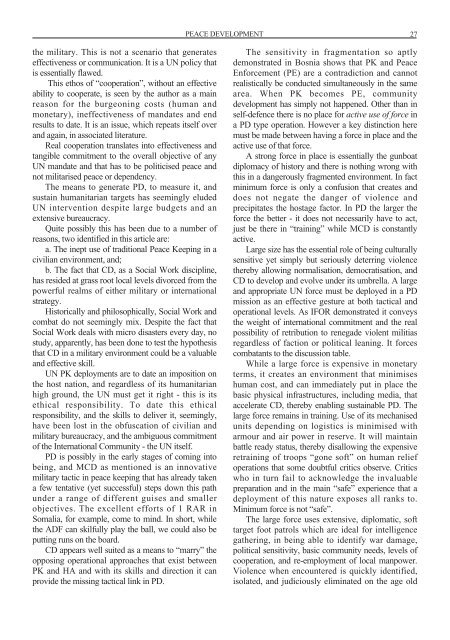ISSUE 136 : May/Jun - 1999 - Australian Defence Force Journal
ISSUE 136 : May/Jun - 1999 - Australian Defence Force Journal
ISSUE 136 : May/Jun - 1999 - Australian Defence Force Journal
- No tags were found...
Create successful ePaper yourself
Turn your PDF publications into a flip-book with our unique Google optimized e-Paper software.
PEACE DEVELOPMENT 27the military. This is not a scenario that generateseffectiveness or communication. It is a UN policy thatis essentially flawed.This ethos of “cooperation”, without an effectiveability to cooperate, is seen by the author as a mainreason for the burgeoning costs (human andmonetary), ineffectiveness of mandates and endresults to date. It is an issue, which repeats itself overand again, in associated literature.Real cooperation translates into effectiveness andtangible commitment to the overall objective of anyUN mandate and that has to be politicised peace andnot militarised peace or dependency.The means to generate PD, to measure it, andsustain humanitarian targets has seemingly eludedUN intervention despite large budgets and anextensive bureaucracy.Quite possibly this has been due to a number ofreasons, two identified in this article are:a. The inept use of traditional Peace Keeping in acivilian environment, and;b. The fact that CD, as a Social Work discipline,has resided at grass root local levels divorced from thepowerful realms of either military or internationalstrategy.Historically and philosophically, Social Work andcombat do not seemingly mix. Despite the fact thatSocial Work deals with micro disasters every day, nostudy, apparently, has been done to test the hypothesisthat CD in a military environment could be a valuableand effective skill.UN PK deployments are to date an imposition onthe host nation, and regardless of its humanitarianhigh ground, the UN must get it right - this is itsethical responsibility. To date this ethicalresponsibility, and the skills to deliver it, seemingly,have been lost in the obfuscation of civilian andmilitary bureaucracy, and the ambiguous commitmentof the International Community - the UN itself.PD is possibly in the early stages of coming intobeing, and MCD as mentioned is an innovativemilitary tactic in peace keeping that has already takena few tentative (yet successful) steps down this pathunder a range of different guises and smallerobjectives. The excellent efforts of 1 RAR inSomalia, for example, come to mind. In short, whilethe ADF can skilfully play the ball, we could also beputting runs on the board.CD appears well suited as a means to “marry” theopposing operational approaches that exist betweenPK and HA and with its skills and direction it canprovide the missing tactical link in PD.The sensitivity in fragmentation so aptlydemonstrated in Bosnia shows that PK and PeaceEnforcement (PE) are a contradiction and cannotrealistically be conducted simultaneously in the samearea. When PK becomes PE, communitydevelopment has simply not happened. Other than inself-defence there is no place for active use of force ina PD type operation. However a key distinction heremust be made between having a force in place and theactive use of that force.A strong force in place is essentially the gunboatdiplomacy of history and there is nothing wrong withthis in a dangerously fragmented environment. In factminimum force is only a confusion that creates anddoes not negate the danger of violence andprecipitates the hostage factor. In PD the larger theforce the better - it does not necessarily have to act,just be there in “training” while MCD is constantlyactive.Large size has the essential role of being culturallysensitive yet simply but seriously deterring violencethereby allowing normalisation, democratisation, andCD to develop and evolve under its umbrella. A largeand appropriate UN force must be deployed in a PDmission as an effective gesture at both tactical andoperational levels. As IFOR demonstrated it conveysthe weight of international commitment and the realpossibility of retribution to renegade violent militiasregardless of faction or political leaning. It forcescombatants to the discussion table.While a large force is expensive in monetaryterms, it creates an environment that minimiseshuman cost, and can immediately put in place thebasic physical infrastructures, including media, thataccelerate CD, thereby enabling sustainable PD. Thelarge force remains in training. Use of its mechanisedunits depending on logistics is minimised witharmour and air power in reserve. It will maintainbattle ready status, thereby disallowing the expensiveretraining of troops “gone soft” on human reliefoperations that some doubtful critics observe. Criticswho in turn fail to acknowledge the invaluablepreparation and in the main “safe” experience that adeployment of this nature exposes all ranks to.Minimum force is not “safe”.The large force uses extensive, diplomatic, softtarget foot patrols which are ideal for intelligencegathering, in being able to identify war damage,political sensitivity, basic community needs, levels ofcooperation, and re-employment of local manpower.Violence when encountered is quickly identified,isolated, and judiciously eliminated on the age old

















